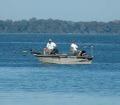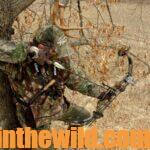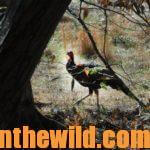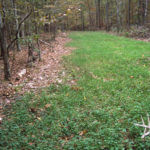John’s Note: You can catch plenty of big slab crappie all year if you know where to fish for them and what baits to use. Then when your taste buds tingle for those tasty, just-popped out of the oven or frying pan fillets of crappie, you won’t have to wait until the spring spawn to catch them. Let’s take a look at the kinds of places where you can find and take crappie throughout the year.
 “To find the biggest crappie in any lake, you’ve got to fish the places no one else knows about with a method no one else uses at a time of year when no one else fishes,” Gaston Jordan of Alabama reports.
“To find the biggest crappie in any lake, you’ve got to fish the places no one else knows about with a method no one else uses at a time of year when no one else fishes,” Gaston Jordan of Alabama reports.
Jordan catches the most crappie during the summer months by fishing the bottom of any lake in the middle of that lake. A lone soul anchored down in a small boat in a vast expanse of water seems out of place on a large lake as water skiers and tournament bass fishermen race by on both sides. But from May through September, Jordan finds the big slab crappie that most other anglers don’t catch. “Usually you’ll locate an abundance of crappie-holding structure in the middles of most lakes,” Jordan says. “But many anglers don’t know how to find that structure. I can catch crappie on submerged structure in lakes all year long.”
With his depth finder, Jordan looks for underwater Indian mounds, submerged home places (especially the ones that still have chimneys or rock walls standing), rock piles and any kind of hump he can pinpoint in 18 to 20 feet of water that drops off into 30 to 40 feet.
Some of these humps only may stand 2 or 3 feet high off the bottom. Although crappie like to hold on brush, they will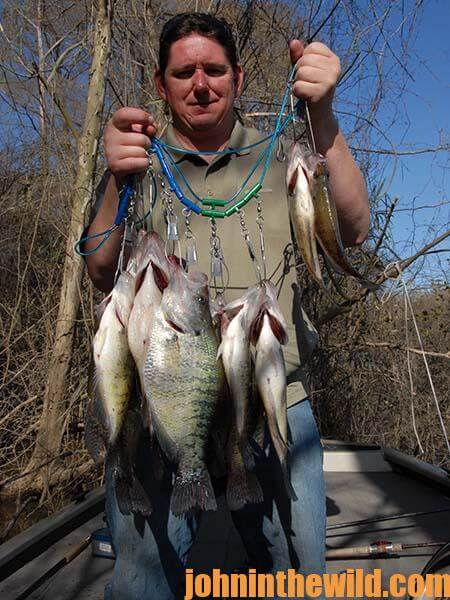 concentrate around rocks, particularly some type of natural rock outcropping. When Jordan discovers a small rock pile that most anglers will ignore when watching their depth finders, he notes its location to return and fish it later. Many of the humps and more-subtle fishing sites Jordan locates he finds in the winter months in drawn-down lakes with their bottoms exposed. Jordan tends to catch bigger crappie on his deep-water places for several reasons. Deep-water crappie rarely, if ever, will see baits other than Jordan’s. Also no one constantly harasses them like they do bank crappie. Too, the crappie will remain on these sites for most of the year, unless someone catches them during the spawn in shallow water.
concentrate around rocks, particularly some type of natural rock outcropping. When Jordan discovers a small rock pile that most anglers will ignore when watching their depth finders, he notes its location to return and fish it later. Many of the humps and more-subtle fishing sites Jordan locates he finds in the winter months in drawn-down lakes with their bottoms exposed. Jordan tends to catch bigger crappie on his deep-water places for several reasons. Deep-water crappie rarely, if ever, will see baits other than Jordan’s. Also no one constantly harasses them like they do bank crappie. Too, the crappie will remain on these sites for most of the year, unless someone catches them during the spawn in shallow water.
“I also take the biggest crappie of the year in the summer months after everyone else has quit fishing, because most people don’t understand what the crappie do after they spawn,” Jordan comments.
“Most everyone knows crappie leave the shallow water and move back to the deep water.”
However, when the fish swim to deep water, they’ll feed heavily to build their bodies back up after the spawn and to develop a layer of fat for the winter. During the summer, you’ll find crappie generally larger in size than at any other time of the year. Since crappie experience very-little fishing pressure from June to September, they can feed as much as they want, get fat and not be caught by anyone but me.”
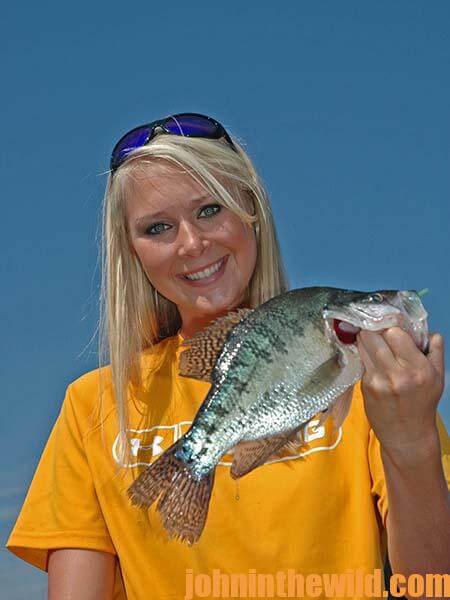 To take the crappie holding on the humps, Jordan anchors down right on top of the mounds, casts his jig into the deep water and bottom-hops the bait up the hump to catch the crappie. “I use a 1/16-ounce, lead-headed, bucktail jig,” Jordan mentions. Four inches above the jig, Jordan adds a 1/16-ounce shot lead to the line. However, he doesn’t pinch the lead all the way down on the line. He wants the line to slip through the shot lead. By rigging this way, he can cast a 1/8-ounce weight out on the end of his line and still fish a 1/16-ounce jig. Since the shot lead will slide down the line and fall faster than the jig will, the weight arrives at the bottom before the jig. Then when he hops the bait off the bottom, the lead will slide to the head of the jig and fall away from the jig as the jig begins to fall to the bottom.
To take the crappie holding on the humps, Jordan anchors down right on top of the mounds, casts his jig into the deep water and bottom-hops the bait up the hump to catch the crappie. “I use a 1/16-ounce, lead-headed, bucktail jig,” Jordan mentions. Four inches above the jig, Jordan adds a 1/16-ounce shot lead to the line. However, he doesn’t pinch the lead all the way down on the line. He wants the line to slip through the shot lead. By rigging this way, he can cast a 1/8-ounce weight out on the end of his line and still fish a 1/16-ounce jig. Since the shot lead will slide down the line and fall faster than the jig will, the weight arrives at the bottom before the jig. Then when he hops the bait off the bottom, the lead will slide to the head of the jig and fall away from the jig as the jig begins to fall to the bottom.
To learn more about crappie and how to fish for them from the masters of the sport, get “Crappie: How to Catch Them Spring and Summer,” and “Reelfoot Lake: How to Fish for Crappie, Bass, Bluegills and Catfish & Hunt for Ducks.” Click here to get these books.
About the Author
John Phillips, winner of the 2012 Homer Circle Fishing Award for outstanding fishing writer by the American Sportfishing Association (AMA) and the Professional Outdoor Media Association (POMA), the 2008 Crossbow Communicator of the year and the 2007 Legendary Communicator chosen for induction into the National Fresh Water Hall of Fame, is a freelance writer (over 6,000 magazine articles for about 100 magazines and several thousand newspaper columns published), magazine editor, photographer for print media as well as industry catalogues (over 25,000 photos published), lecturer, outdoor consultant, marketing consultant, book author and daily internet content provider with an overview of the outdoors.

